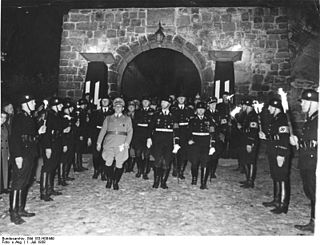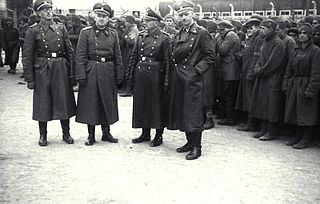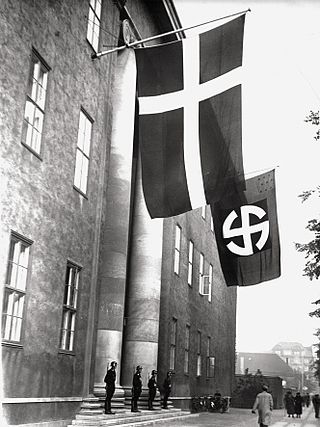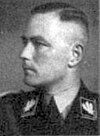
The Schutzstaffel was a major paramilitary organisation under Adolf Hitler and the Nazi Party in Nazi Germany, and later throughout German-occupied Europe during World War II.

Gottlob Christian Berger was a senior German Nazi official who held the rank of SS-Obergruppenführer und General der Waffen-SS and was the chief of the SS Main Office responsible for Schutzstaffel (SS) recruiting during World War II. At the post-war Nuremberg trials, the Waffen-SS – within which Berger was a senior officer – was declared to be a criminal organisation due to its major involvement in war crimes and crimes against humanity. Berger was convicted as a war criminal and spent six and a half years in prison.

The uniforms and insignia of the Schutzstaffel (SS) served to distinguish its Nazi paramilitary ranks between 1925 and 1945 from the ranks of the Wehrmacht, the German state, and the Nazi Party.
SS-Verfügungstruppe was formed in 1934 as combat troops for the Nazi Party (NSDAP). On 17 August 1938 Adolf Hitler decreed that the SS-VT was neither a part of the Ordnungspolizei nor the Wehrmacht, but military-trained men at the disposal of the Führer. In time of war, the SS-VT were to be placed at the disposal of the army.

Reichsführer-SS was a special title and rank that existed between the years of 1925 and 1945 for the commander of the Schutzstaffel (SS). Reichsführer-SS was a title from 1925 to 1933, and from 1934 to 1945 it was the highest rank of the SS. The longest-serving and most noteworthy office holder was Heinrich Himmler.

The Allgemeine SS was a major branch of the Schutzstaffel (SS) paramilitary forces of Nazi Germany; it was managed by the SS Main Office (SS-Hauptamt). The Allgemeine SS was officially established in the autumn of 1934 to distinguish its members from the SS-Verfügungstruppe, which later became the Waffen-SS, and the SS-Totenkopfverbände, which were in charge of the Nazi concentration camps and extermination camps. SS formations committed many war crimes against civilians and allied servicemen.

Oberführer was an early paramilitary rank of the Nazi Party (NSDAP) dating back to 1921. An Oberführer was typically an NSDAP member in charge of a group of paramilitary units in a particular geographical region. From 1921 to 1925, the phrase Oberführer was used as a title in the Sturmabteilung (SA), but became an actual SA rank after 1926.

SS-Totenkopfverbände was the Schutzstaffel (SS) organization responsible for administering the Nazi concentration camps and extermination camps for Nazi Germany, among similar duties. While the Totenkopf was the universal cap badge of the SS, the SS-TV also wore this insignia on the right collar tab to distinguish itself from other SS formations.

The Germanic SS was the collective name given to paramilitary and political organisations established in parts of German-occupied Europe between 1939 and 1945 under the auspices of the Schutzstaffel (SS). The units were modeled on the Allgemeine SS in Nazi Germany and established in Belgium, Denmark, the Netherlands, and Norway—population groups who were considered to be especially "racially suitable" by the Nazis. They typically served as local security police augmenting German units of the Gestapo, Sicherheitsdienst (SD), and other departments of the German Reich Security Main Office (RSHA), rendering them culpable for their participation in Nazi atrocities.
The SS Führungshauptamt (SS-FHA) was the operational headquarters of the SS during the Nazi era.

During World War II, Germanische Leitstelle was a department of the SS-Hauptamt under the command of Obergruppenführer Gottlob Berger. It oversaw the recruitment and propaganda offices for the Waffen SS in Oslo, Copenhagen, Brussels and The Hague.
Units and commands of the Schutzstaffel were organizational titles used by the SS to describe the many groups, forces, and formations that existed within the SS from its inception in 1923 to the eventual fall of Nazi Germany in 1945.

During World War II, the Waffen-SS recruited significant numbers of non-Germans, both as volunteers and conscripts. In total some 500,000 non-Germans and ethnic Germans from outside Germany, mostly from German-occupied Europe, were recruited between 1940 and 1945. The units were under the control of the SS Führungshauptamt beneath Reichsführer-SS Heinrich Himmler. Upon mobilisation, the units' tactical control was given to the Oberkommando der Wehrmacht.

The Allgemeine-SS regional commands were titled SS-Oberabschnitte and first were established on November 16, 1933. They replaced the earlier command structure composed of five SS-Gruppen and comprised the regional component of the Allgemeine-SS command structure. They reported to the SS-Amt, in 1935 renamed the SS-Hauptamt. Their commanders carried the title of SS-Oberabschnitte Führer and usually held the rank of SS-Gruppenführer or SS-Obergruppenführer. Beginning in November 1937, when the Higher SS and Police Leaders were established, the SS-Oberabschnitte were subordinated to them. However, in nearly every instance, the SS-Oberabschnitt Führer held both positions simultaneously. The Oberabschnitt Führer's staff was headed by a Stabschef who oversaw departments encompassing administration, training, personnel, medical affairs, as well as specialty units such as signals and engineer battalions.
Kriminalpolizei, often abbreviated as Kripo, is the German name for a criminal investigation department. This article deals with the agency during the Nazi era.
The SS Education Office (SS-Schulungsamt) was one of the Nazi organizations responsible for the ideological indoctrination of members of the SS. The office operated initially under the jurisdiction of the Reich Race and Settlement Office (RuSHA) but was later subordinated to the SS Main Office (SS-Hauptamt).
In Nazi Germany, the Standarte was a paramilitary unit of Nazi Party (NSDAP), Sturmabteilung (SA), NSKK, NSFK, and Schutzstaffel (SS). Translated literally as "Regimental standard", the name refers to the flag paramilitary formations carried in formations and parades.
Mark C. Yerger was an American author of books about the Schutzstaffel and Waffen-SS of Nazi Germany. He had close contacts to SS veterans, through whom he was able to access private archives, and wrote biographies of commanders and award recipients of the SS and of SS units. Historians of World War II have described Yerger's work as uncritical, hagiographic and whitewashing towards the SS.

Walter Staudinger was a German SS-Gruppenführer and Generalleutnant of the Waffen SS.
Otto Hugo Hans Schwedler was a German Nazi SS-Brigadeführer and Generalmajor of the Waffen-SS who served as the SS and Police Leader in the Kraków District during the establishment of the Kraków Ghetto. He also was involved in the administration of the Nazi concentration camp system, and committed suicide close to the end of the Second World War in Europe.
















